Etrain used the source code from a paper by the University of Manchester for the Cough-based COVID-19 Detection Challenge.
The dataset you will download from the web of the competition. Download and extract the dataset
%cd /content/
!unzip -q /content/aicv115m_public_train.zip -d ./
!unzip -q /content/aicv115m_public_train/train_audio_files_8k.zip
!unzip -q /content/aicv115m_private_test.zip -d ./
Import libraries
import librosa
import librosa.display
from tqdm import tqdm
import pandas as pd
import numpy as np
import os
from sklearn.model_selection import train_test_split
from tensorflow import keras
from tensorflow.keras.models import Sequential
from tensorflow.keras.layers import BatchNormalization, Conv2D, Dense, GlobalAveragePooling2D
from tensorflow.keras.callbacks import ModelCheckpoint, EarlyStopping, ReduceLROnPlateau
from tensorflow.keras.optimizers import Adam
from tensorflow.keras import optimizers
from tensorflow.keras.utils import plot_model
from datetime import datetime
from sklearn.metrics import classification_report, confusion_matrix, accuracy_score
import matplotlib
import matplotlib.pyplot as plt
import itertools
import pylab
Load the train.csv file
train_df = pd.read_csv("/content/aicv115m_public_train/metadata_train_challenge.csv")
train_df
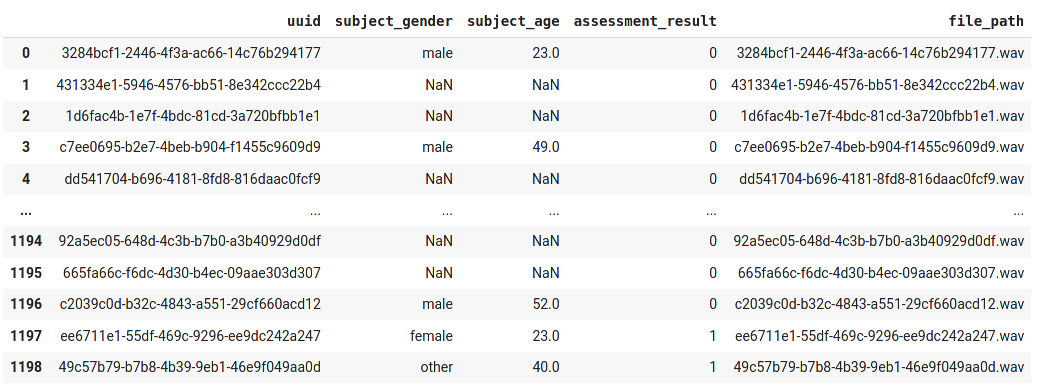
Use the Librosa Python library to extract features
# Reshape the data
target_names = ['not_covid', 'covid']
num_rows = 120
num_columns = 431
num_channels = 1
def extract_features(file_name):
try:
"""
Load and preprocess the audio
"""
audio, sample_rate = librosa.load(file_name)
y = audio
"""
Convert to MFCC numpy array
"""
max_pad_length = 431
n_mfcc = 120
n_fft = 4096
hop_length = 512
n_mels = 512
mfccs = librosa.feature.mfcc(y=y, sr=sample_rate, n_mfcc=n_mfcc, n_fft=n_fft, hop_length=hop_length, n_mels=n_mels)
pad_width = max_pad_length-mfccs.shape[1]
mfccs = np.pad(mfccs, pad_width=((0,0),(0,pad_width)), mode='constant')
except Exception as e:
print("Error encountered while parsing file: ", e)
return None, sample_rate
return mfccs, sample_rate
mfcc_image_path = "mfcc"
if not os.path.exists(mfcc_image_path):
os.makedirs(mfcc_image_path)
def plot_mfcc(filename, mfcc, sr):
plt.figure(figsize=(10, 4))
librosa.display.specshow(librosa.amplitude_to_db(mfcc, ref=np.max), y_axis='mel', x_axis='time', sr=sr)
plt.colorbar(format='%+2.0f dB')
plt.title(filename)
plt.tight_layout()
pylab.savefig(os.path.join(mfcc_image_path, filename+'.png'), bbox_inches=None, pad_inches=0)
pylab.close()
def process_dataset(df, PLOT_MFCC):
features = []
for index, row in tqdm(df.iterrows(), total=df.shape[0]):
file_properties = row["file_path"]
file_name = '/content/train_audio_files_8k/'+file_properties
class_label = row["assessment_result"]
data, sr = extract_features(file_name)
if data is not None:
features.append([data, class_label])
# Save an image of the MFCC
if PLOT_MFCC:
plot_mfcc(file_properties+'_'+str(class_label), data, sr)
else:
print("Data is empty: ", file_name)
# Convert into a Panda dataframe
featuresdf = pd.DataFrame(features, columns=['feature','class_label'])
print(featuresdf)
print('Finished feature extraction from ', len(featuresdf), ' files')
# Convert features and corresponding classification labels into numpy arrays
X = np.array(featuresdf.feature.tolist())
y = np.array(featuresdf.class_label.tolist())
return X, y
X, y = process_dataset(train_df, True)
Split train and valid dataset
# Split the dataset
x_train, x_test, y_train, y_test = train_test_split(X, y, test_size=0.1, random_state = 42)
x_train = x_train.reshape(x_train.shape[0], num_rows, num_columns, num_channels)
x_test = x_test.reshape(x_test.shape[0], num_rows, num_columns, num_channels)
print(x_train.shape, x_test.shape, y_train.shape, y_test.shape)
Define the CNN model
def CNN():
# Construct model
model = Sequential()
model.add(Conv2D(16, (7,7), input_shape=(num_rows, num_columns, num_channels), activation='relu', padding="same"))
model.add(BatchNormalization())
model.add(Conv2D(32, (3,3), activation='relu', padding="same"))
model.add(BatchNormalization())
model.add(Conv2D(64, (3,3), activation='relu', padding="same"))
model.add(BatchNormalization())
model.add(Conv2D(128, (3,3), activation='relu', padding="same"))
model.add(BatchNormalization())
model.add(Conv2D(256, (3,3), activation='relu', padding="same"))
model.add(BatchNormalization())
model.add(Conv2D(512, (1,1), activation='relu', padding="same"))
model.add(BatchNormalization())
model.add(GlobalAveragePooling2D())
model.add(Dense(1, activation='sigmoid'))
learning_rate = 0.00001
opt = optimizers.Adam(learning_rate=learning_rate)
model.compile(loss='binary_crossentropy', metrics=['accuracy'], optimizer=opt)
model.summary()
return model
cnn_model = CNN()
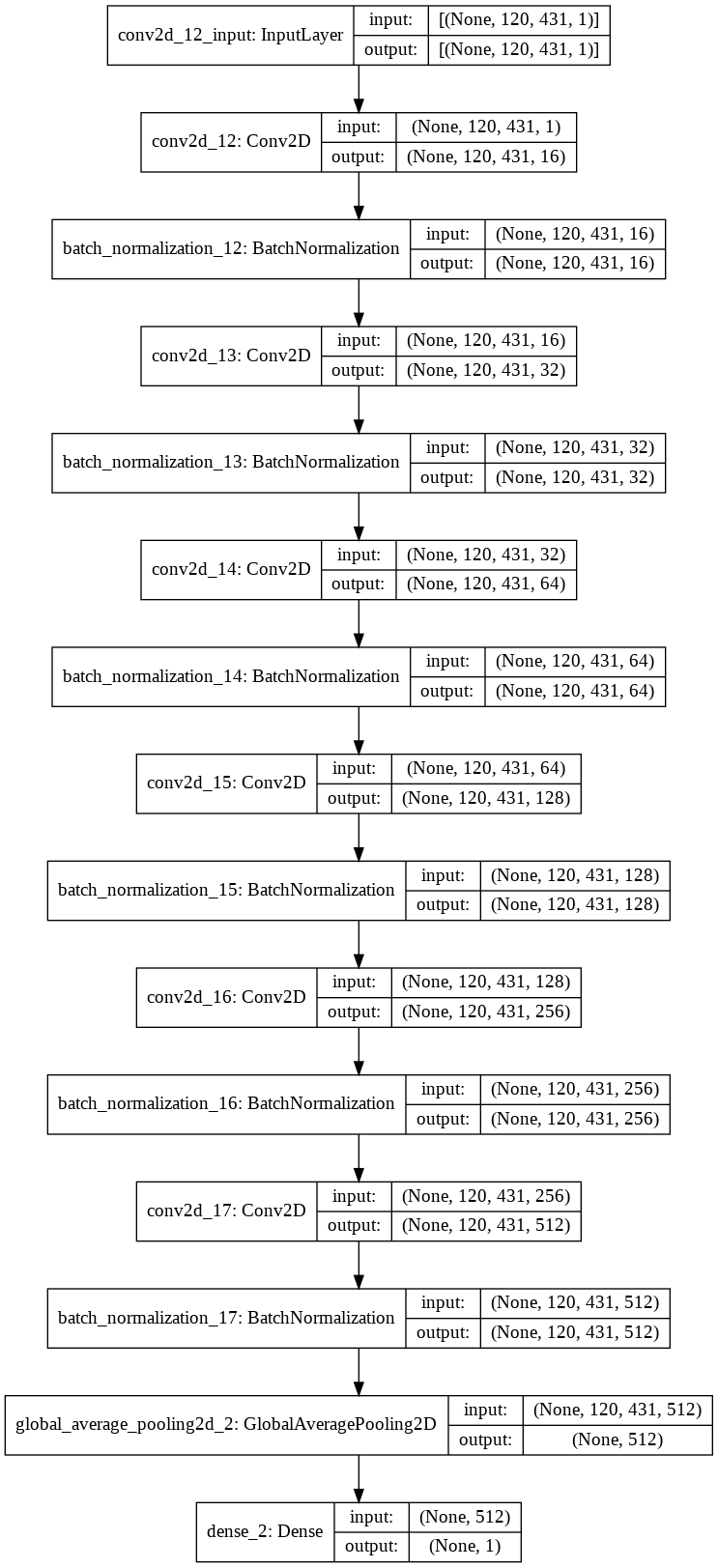
Train model
def train_model(model, x_train, x_test, y_train, y_test):
# Calculate pre-training accuracy
score = model.evaluate(x_test, y_test, verbose=1)
accuracy = 100*score[1]
print("Pre-training accuracy: %.4f%%" % accuracy)
# Train the model
num_epochs = 100
num_batch_size = 10
start = datetime.now()
checkpointer = ModelCheckpoint(filepath='saved_models/weights.best.basic_cnn.hdf5', verbose=1, save_best_only=True)
es_callback = EarlyStopping(monitor='val_loss', patience=10, verbose=1)
reduce_lr = ReduceLROnPlateau(monitor='val_loss', factor=0.0001, patience=7, verbose=1, mode='auto', min_delta=0.001, cooldown=1, min_lr=0)
history = model.fit(x_train, y_train, batch_size=num_batch_size, epochs=num_epochs, validation_split=0.2, shuffle=False, callbacks = [checkpointer, es_callback], verbose=2)
#history = model.fit(x_train, y_train, batch_size=num_batch_size, epochs=num_epochs, validation_data=(x_test, y_test), shuffle=True, callbacks=[checkpointer], verbose=1)
duration = datetime.now() - start
print("Training completed in time: ", duration)
# Evaluating the model on the training and testing set
score = model.evaluate(x_train, y_train, verbose=0)
print("Training Accuracy: ", score[1])
score = model.evaluate(x_test, y_test, verbose=0)
print("Testing Accuracy: ", score[1])
return history
history = train_model(cnn_model, x_train, x_test, y_train, y_test)
The accuracy and loss result
mfcc_image_path = "plots"
if not os.path.exists(mfcc_image_path):
os.makedirs(mfcc_image_path)
def plot_graphs(history):
# Plot training & validation accuracy values
plt.plot(history.history['accuracy'])
plt.plot(history.history['val_accuracy'])
plt.title('Model accuracy')
plt.ylabel('Accuracy')
plt.xlabel('Epoch')
plt.legend(['Train', 'Test'], loc='upper left')
#plt.show()
plt.savefig('plots/accuracy.png')
plt.clf()
# Plot training & validation loss values
plt.plot(history.history['loss'])
plt.plot(history.history['val_loss'])
plt.title('Model loss')
plt.ylabel('Loss')
plt.xlabel('Epoch')
plt.legend(['Train', 'Test'], loc='upper left')
#plt.show()
plt.savefig('plots/loss.png')
plt.close()
plot_graphs(history)
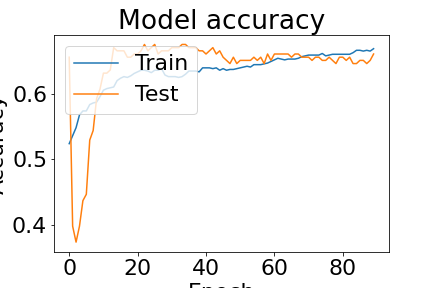
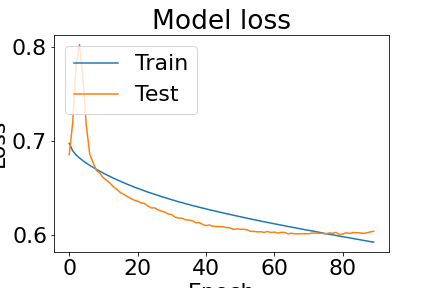
confusion_matrix and classification_report
def plot_classification_report(x_test, y_test):
# Print
print(classification_report(x_test, y_test, target_names=target_names))
# Save data
clsf_report = pd.DataFrame(classification_report(y_true = x_test, y_pred = y_test, output_dict=True, target_names=target_names)).transpose()
clsf_report.to_csv('plots/classification_report.csv', index= True)
def plot_confusion_matrix(cm, target_names, title='Confusion matrix', cmap=None, normalize=True):
matplotlib.rcParams.update({'font.size': 22})
accuracy = np.trace(cm) / float(np.sum(cm))
misclass = 1 - accuracy
if cmap is None:
cmap = plt.get_cmap('Blues')
plt.figure(figsize=(14, 12))
plt.imshow(cm, interpolation='nearest', cmap=cmap)
plt.title(title)
plt.colorbar()
if target_names is not None:
tick_marks = np.arange(len(target_names))
plt.xticks(tick_marks, target_names, rotation=45)
plt.yticks(tick_marks, target_names)
if normalize:
cm = cm.astype('float') / cm.sum(axis=1)[:, np.newaxis]
thresh = cm.max() / 1.5 if normalize else cm.max() / 2
for i, j in itertools.product(range(cm.shape[0]), range(cm.shape[1])):
if normalize:
plt.text(j, i, "{:0.4f}".format(cm[i, j]),
horizontalalignment="center",
color="white" if cm[i, j] > thresh else "black")
else:
plt.text(j, i, "{:,}".format(cm[i, j]),
horizontalalignment="center",
color="white" if cm[i, j] > thresh else "black")
plt.tight_layout()
plt.ylabel('True label')
plt.xlabel('Predicted label\naccuracy={:0.4f}; misclass={:0.4f}'.format(accuracy, misclass))
plt.savefig('plots/confusion_matrix.png', bbox_inches = "tight")
plt.close()
model = keras.models.load_model('/content/saved_models/weights.best.basic_cnn.hdf5')
y_pred = model.predict(x_train)
predictions = (y_pred > 0.5).astype("int32")
predictions = [p for p in predictions]
cm = confusion_matrix(y_train, predictions)
plot_confusion_matrix(cm, target_names)
plot_classification_report(y_train, predictions)
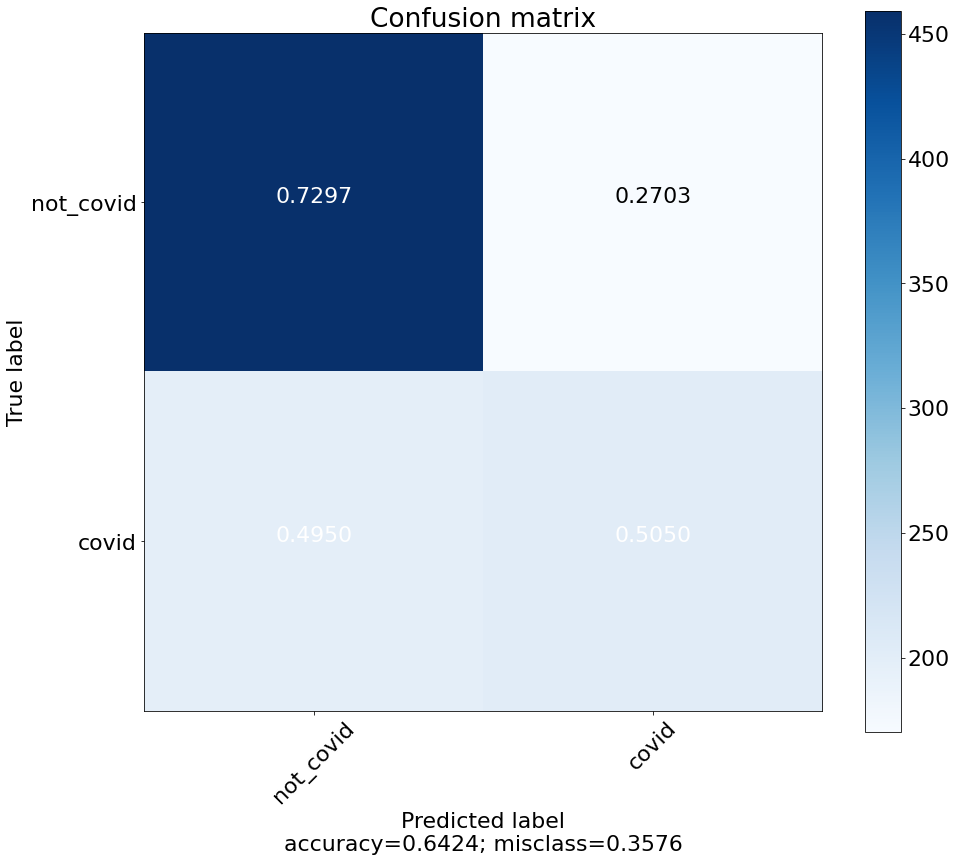

The private test score in the stage of beginning is: 0.643352
